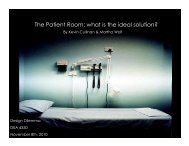The role of physical design and informal communication
The role of physical design and informal communication
The role of physical design and informal communication
You also want an ePaper? Increase the reach of your titles
YUMPU automatically turns print PDFs into web optimized ePapers that Google loves.
concluded that high visibility workstations appear to promote <strong>communication</strong> by<br />
allowing face-to-face <strong>communication</strong> to occur more easily. Dutta (2008) cites a study<br />
by Allen (1977) who found that <strong>physical</strong> proximity in an R&D setting played a key<br />
<strong>role</strong> in the amount <strong>of</strong> interaction that occurred. <strong>The</strong> results showed that the likelihood<br />
<strong>of</strong> <strong>communication</strong> <strong>and</strong> collaboration between team members decreased rapidly with<br />
distance. In fact, <strong>communication</strong> reached its lowest point after the first twenty-five or<br />
thirty meters.<br />
1.9.1 Impact <strong>of</strong> Nursing Unit Design on Communication<br />
Although a moderate body <strong>of</strong> research exists concerning the effect <strong>of</strong> the<br />
<strong>physical</strong> <strong>design</strong> <strong>of</strong> space on <strong>communication</strong> in corporate settings, very little research<br />
has been conducted with the same focus in healthcare settings. Research in hospitals<br />
has confirmed the importance <strong>of</strong> <strong>communication</strong> not only for team functioning, which<br />
impacts the quality <strong>of</strong> patient care <strong>and</strong> nurse job satisfaction, but also for tacit<br />
knowledge transfer <strong>and</strong> <strong>informal</strong> learning. However, a gap in the literature exists<br />
when it comes to the influence <strong>of</strong> nursing unit <strong>design</strong> on opportunistic <strong>communication</strong><br />
<strong>and</strong> on-the-job learning.<br />
1.9.1.1 Centralized vs. Decentralized Nursing Unit Designs<br />
<strong>The</strong> concept <strong>of</strong> spatial transparency that has been illustrated in many studies <strong>of</strong><br />
corporate environments is applicable to healthcare as well. Visual <strong>and</strong> <strong>physical</strong><br />
proximity <strong>and</strong> its impact on <strong>communication</strong> is particularly relevant in the current<br />
debate concerning centralized vs. decentralized nurses’ stations. Researchers are<br />
beginning to explore their implications for quality <strong>of</strong> care <strong>and</strong> staff efficiency <strong>and</strong> are<br />
discovering that while the advantages <strong>of</strong> decentralized units, including a reduction in<br />
the time spent walking <strong>and</strong> being away from the patient, appear to surpass those <strong>of</strong><br />
20







